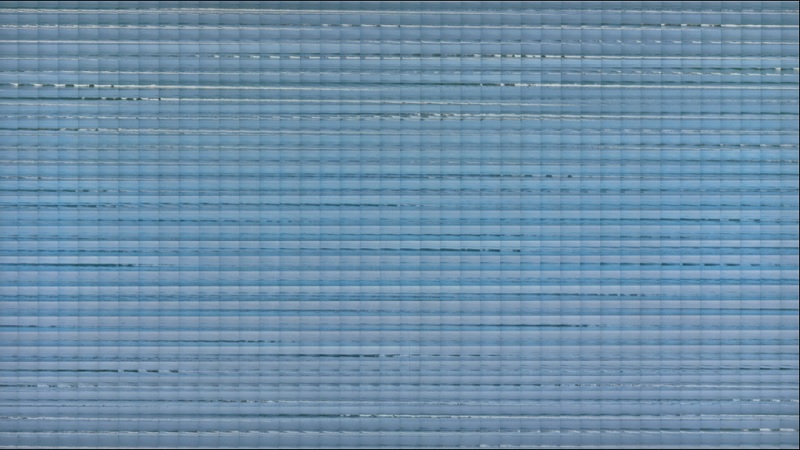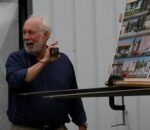Landscapes in Passing (Smithsonian video 2:11)

Robbert Flick
Dutch, 1939- (active USA)
At Cambria, 2002
ilfochrome, ed. 1/5
39 5/8 x 71 3/8 in.
SBMA, Museum purchase with funds provided by Eric Skipsey
2003.5

Robbert Flick - undated photograph
“What becomes important is the trajectory that you take through that overload. That’s really the only thing that’s left that you have. How do we navigate through it with sense? How do you create value out of that? What is valuable within it? In the end, it’s only the trajectories through it that you construct that will allow you to create some kind of meaning.” – Robbert Flick
COMMENTS
Robbert Flick is what you get when you harness the intellectual horsepower of an academic to the irrepressible curiosity of a child who takes apart a bicycle to figure out the relationship between a heap of metal parts and the weightless glide of the ride. For more than 30 years, the photographer has been taking apart continuous visual experience, breaking it down into discrete images and putting them back together again into works that variably look like a mosaic, feel like a film and operate like a map.
At 64, Flick has an elegant bearing: tall, sturdy, crisply groomed. Conversation about his work - in the galleries at the Los Angeles County Museum of Art, where his first large-scale retrospective opened Sept. 12 - quickly becomes dense and complex but stays accessible, much like the work itself. The phrase “in a sense” peppers Flick’s speech. It’s a standard conversational filler that he’s reinvested with intent: Every interpretation is just one of many possibilities; each work is open-ended, a “nexus point” generating multiple readings.
“Trajectories: The Photographic Work of Robbert Flick” covers more than 30 years of ground. The installation progresses fairly logically, says curator Tim Wride. “One project really did lead clearly to the next, by virtue of the fact that Robbert really intellectualizes his work. He’s thinking about what it means to take pictures and what that practice implies.”
The earliest photographs date from the late ‘60s, when Flick moved to L.A. from Vancouver, Canada, to attend graduate school. (He was born in Holland and raised there and in the West Indies.) From the start, his work focused on the landscape, both rural and urban, and on the condensation of visual experience.
For “L.A. Diary,” Flick shot dozens of rolls of film over and over again, making multiple exposures in the camera. “All of that is rooted in a way of photographing that comes out of the ‘60s and has to do with chance, chance operations - [John] Cage and all of that stuff,” he explains.
In the surprisingly lucid, tight montages, traffic signals, shadows, signs and clocks interlock. “They’re not pictures of something, they’re objects about something. The way I photographed there was not to frame something but just to acknowledge it. So it was a gesture, and the gesture was a completion of something. These gestures of completion would layer themselves on the film, because I would multiple expose them three to seven times.”
After completing his master of fine arts degree at UCLA in 1971, Flick took a teaching position at the University of Illinois at Urbana-Champaign. The “Midwest Diary” he shot over the next five years is, according to Wride, “a very urban take on a rural landscape.” Some of the images of cornfields verge on lushly sensuous, but more typical are detached views of isolated structures - fences, homes, gravestones. The centralizing gaze of Walker Evans can be felt here, as can the insistent neutrality of New Topographics photographers such as Lewis Baltz and Robert Adams.
Flick returned to L.A. in 1976 to begin teaching at USC, where he remains on the faculty. The same year, he married artist Susan Rankaitis, currently chair of the art department at Scripps College in Claremont, where they live. He began pairing images (“L.A. Doubles”) and investigating the forms and shifting light in a parking garage behind his studio. The “Arena Series” pictures range from Malevich-simple compositions in tones of gray to Kafka-esque set pieces with claustrophobically low ceilings and views that dead-end in concrete-block walls or dank corners.
Profundity in numbers
In 1979, he began the “Sequential Views,” making pictures along a certain geographic trajectory and editing the results into a grid montage, a format that he’s adhered to, with variations, for the past 20 years. He developed the strategy after being invited to participate in “L.A. 200,” a documentary project funded by a National Endowment for the Arts Survey Grant.
“It became very clear to me that single pictures would not make any sense trying to represent Los Angeles, so there was a need for a methodology,” Flick says, his trace of an accent sanding down each “th” sound to a cushioned “d.”
Within the city, he began to walk predetermined routes and make exposures at prescribed intervals. He would shoot a frame at each intersection, for instance, looking north. The finished pieces might organize a hundred separate images into a neat grid. Spatial and temporal continuity are suggested in the progression from left to right and top to bottom, but Flick’s orderly system breathes organically on the page. There is no single correct way to read these works. They have the rhythm and texture of fugues, tapestries of forms that repeat, pattern, circle around, layer and echo.
Despite having their basis in a conceptual exercise, the “Sequential Views,” especially those made in the desert or looking at the ocean, can be beautifully poetic. One piece evokes the calligraphy of reeds. Another, made at Joshua Tree, takes a blinking sweep of the landscape, alighting on sun-bleached rocks and haloed cactuses that dance forward and recede as Flick alters his stance.
“At Joshua Tree,” Wride comments, “the system is basically dictated by his walk: looking at, looking through, looking away and looking back at. It’s an elegant blend of what’s seemingly neutral and an empathic, intuitive way of working.”
Wride describes the L.A.-based work that Flick has made over two decades as “a kind of genome mapping of an urban space.” Flick refers to himself as an archivist.
“One of the things that motivated me was that I saw Los Angeles change. It changed so drastically over the last 30 years.” Although he says that he’s not driven specifically by a desire to preserve what he sees, he keeps returning to the question “What was this like? One of the things I still remember from high school was this question of the Middle Ages, what they looked like. We have no idea.”
Of car and camera
Flick continued to identify trajectories through the city and began to drive them, shooting out his car window with a video camera mounted behind his seat.
“I picked, for instance, Pico, because to my mind it was an extraordinary cross section of Los Angeles. It goes right from the beach to Central Avenue and cuts through all these demographics.” In Pasadena, he photographed the length of the Rose Parade, creating an accordion-fold book of the route that harks back to Ed Ruscha’s 1966 book, “Every Building on the Sunset Strip.”
Around 1991, Flick added digital technology to his repertoire and began to do his editing and selecting on screen. Wride vividly recalls his first visit to Flick’s studio, around this time.
“I had never done a studio visit with anyone that didn’t have chemicals around. It was really eye-opening. The problem with digital work has always been that it was about being digital, not about the work. It was too much about process, doing something because it could be done, not because it should be done. Here was someone using digital technology as a tool .... It was a benchmark.”
In the “L.A. Documents,” an ongoing series, there is no longer white space between the separate frames. There is no downtime for the eye. Images (color, now) stream across the page, echoing the continuous video footage from which they’re extracted. Forms are clipped and sometimes stutter, but the pace continues unchecked.
Continuous time is dissected in these images into its constituent moments, like the late 19th century motion studies by Eadweard Muybridge. Unlike Muybridge’s work, however, Flick’s is less about presenting annotated evidence than it is about gathering impressions.
That’s especially true of the most recent work in the show, three large, luminous images of the ocean at Cambria. The rhythm of the surf plays out over and over, waves building and breaking then building again. From a distance, though, each montage of hundreds of images taken over a 45-minute span reads as a single field of light and space. In one, cool silvery blue dissolves into warm dusty rose and smoky violet.
It’s as classic as landscape subjects get - sunset over the sea - but for Flick, this work is a natural extension of his interest in the contemporary condition of image overload.
- Leah Ollman, In Search of the Big Picture, New York Times, 26 September, 2004
